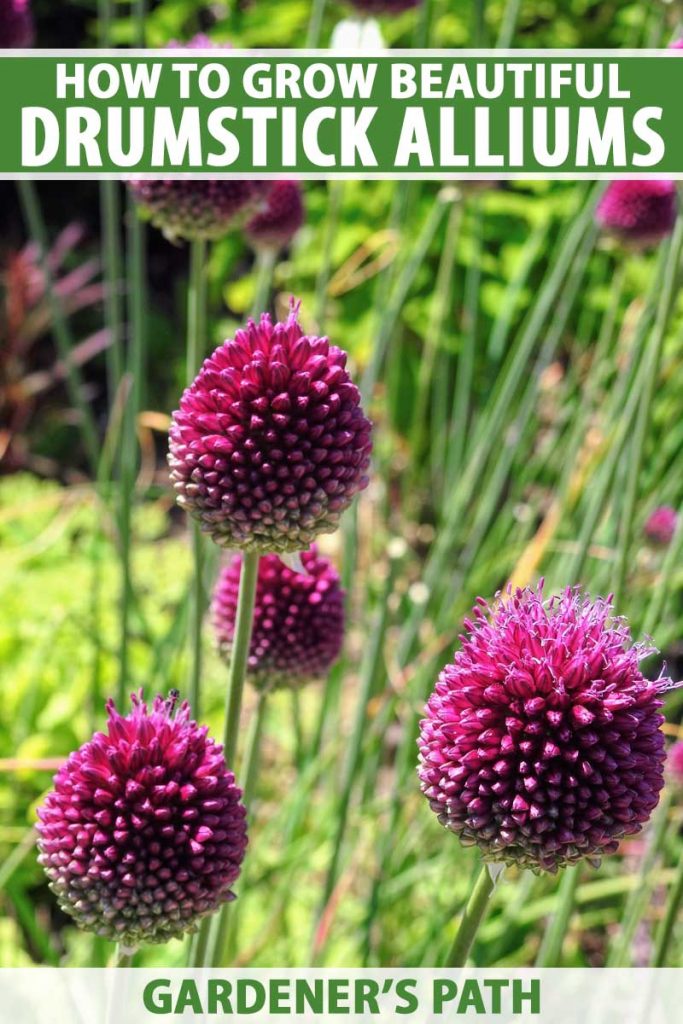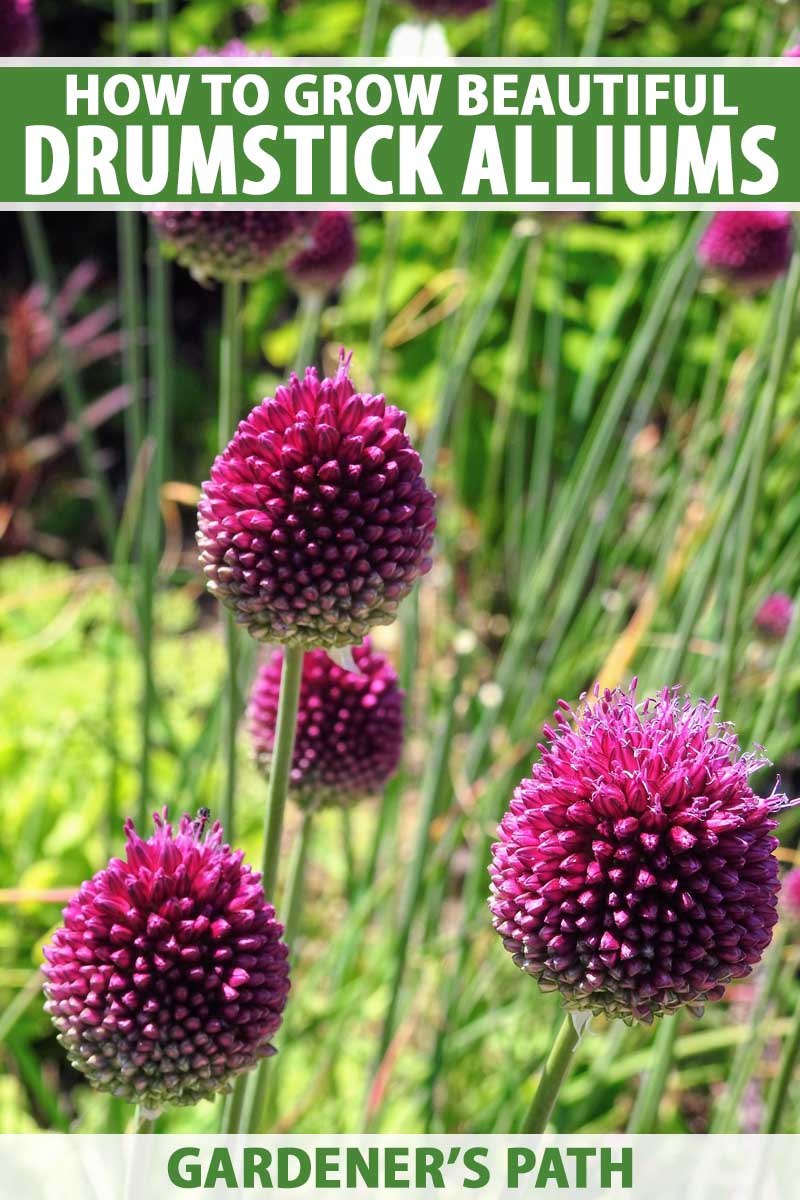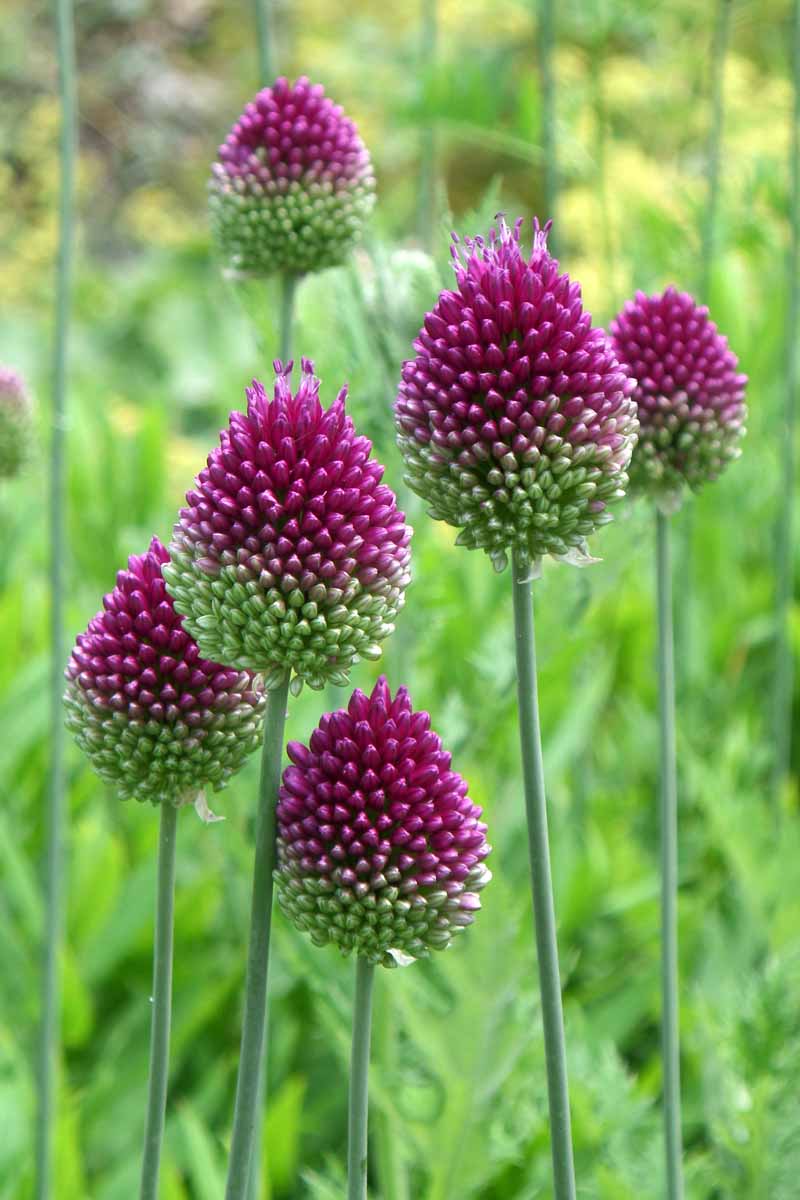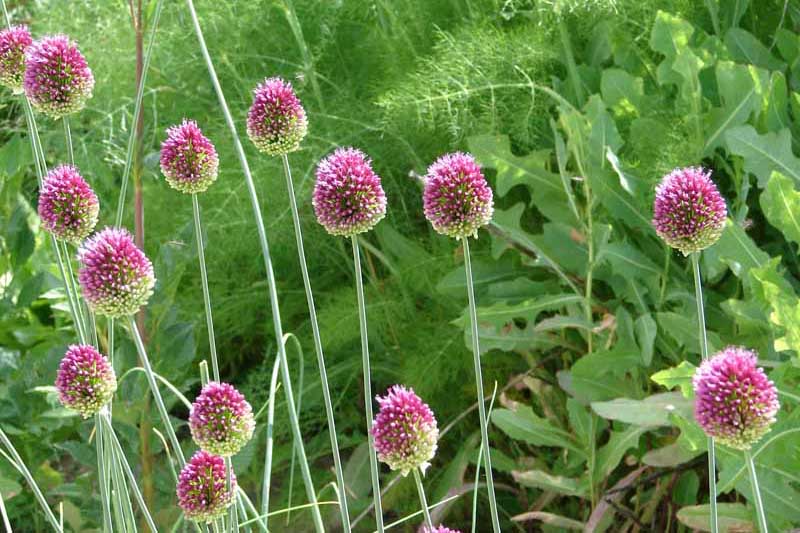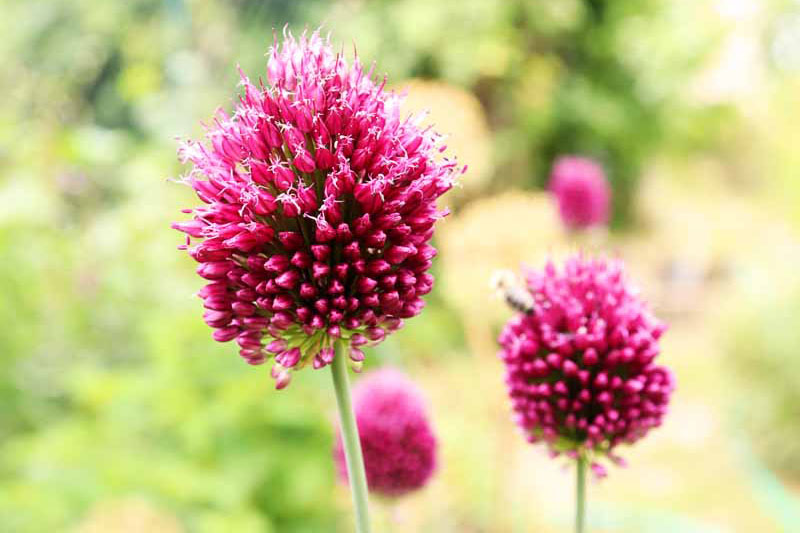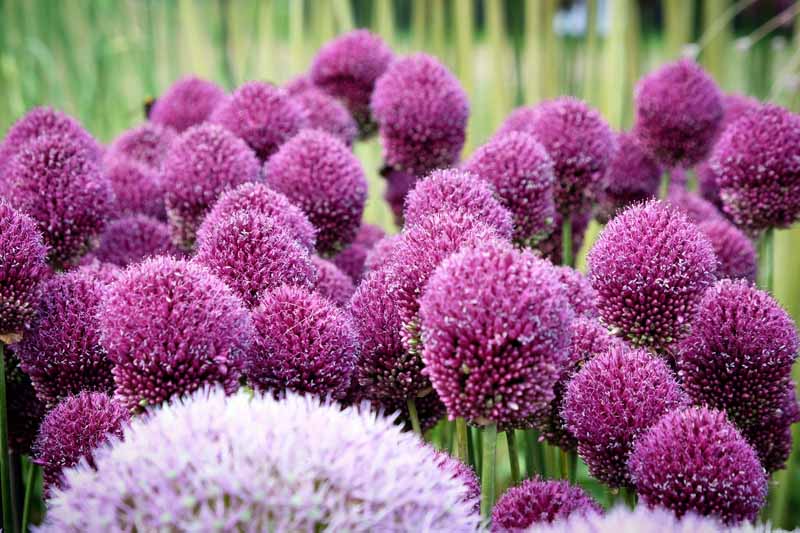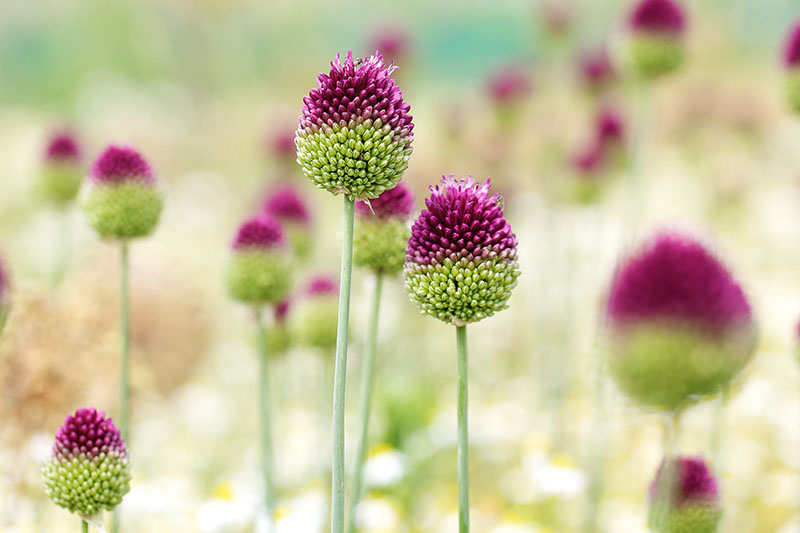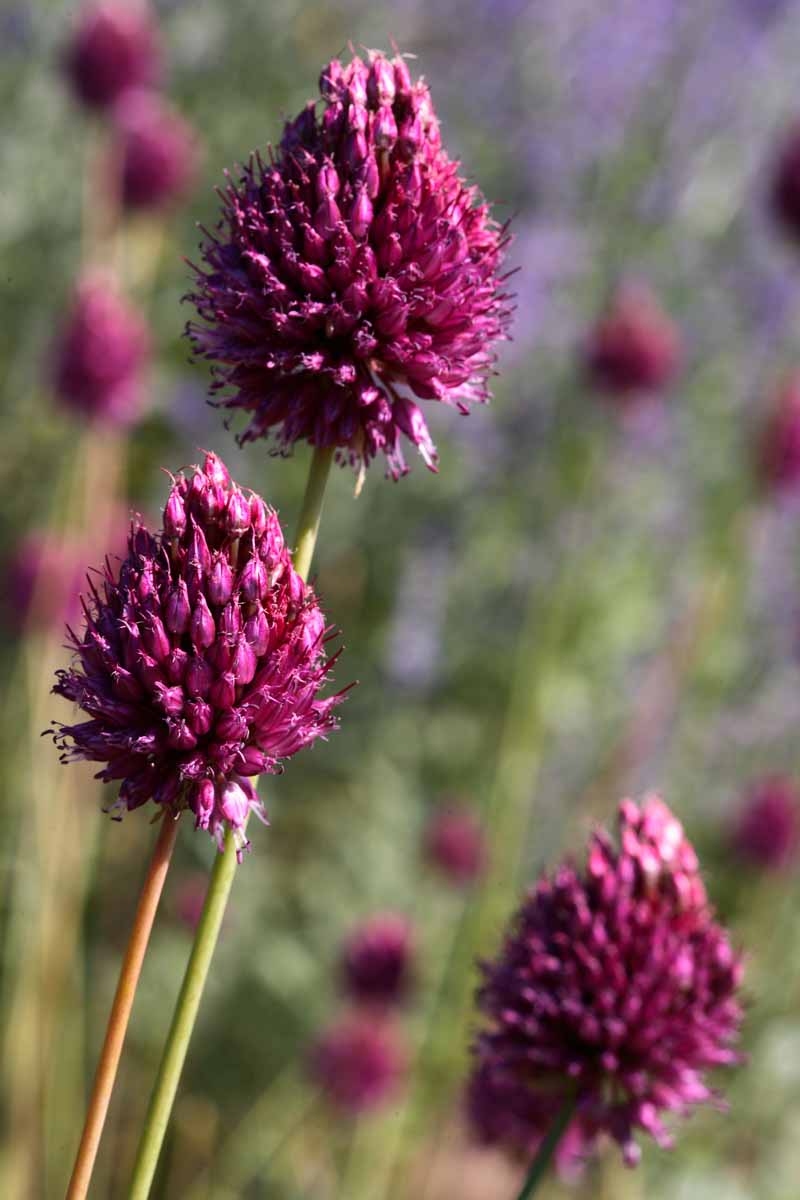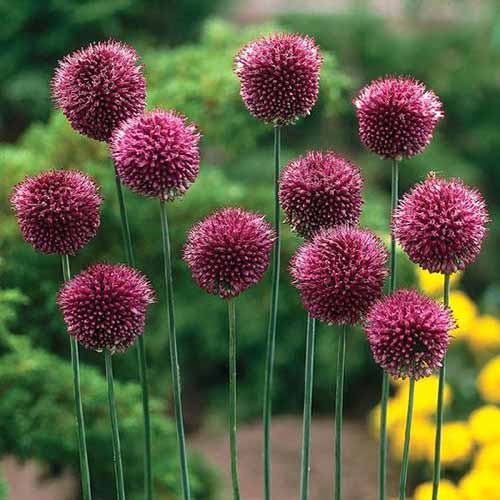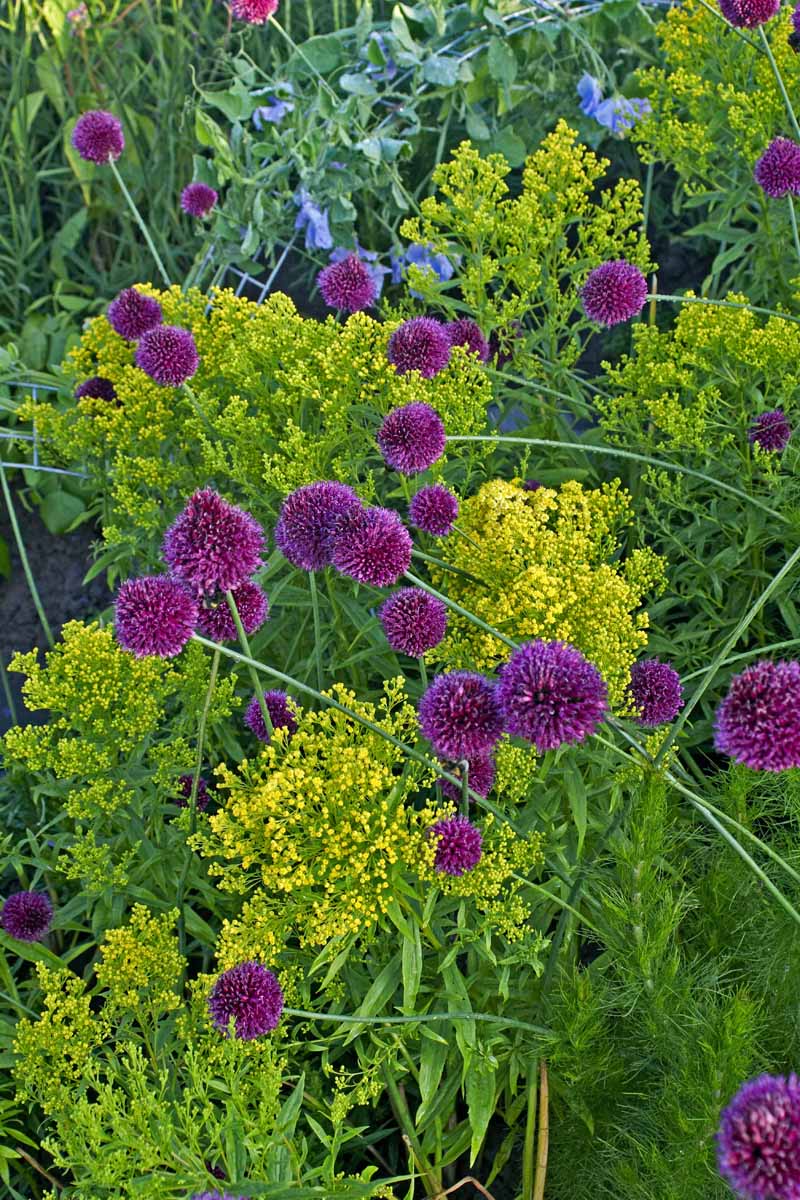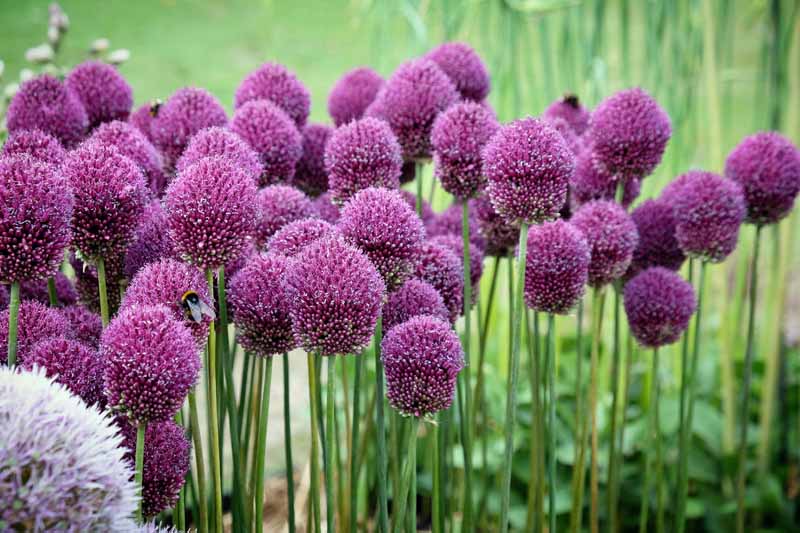When you see these plants growing, you’ll know immediately why they earned the name “drumstick.” And they’re perfect for adding interest to the garden in summertime. They have tall, thin stems topped with a tight knot of flowers, which gives them an appearance not unlike the musical accessory. We link to vendors to help you find relevant products. If you buy from one of our links, we may earn a commission. While they might not have the percussive might of a solid piece of hickory, they certainly had the look I was after. These days, I take just as much pleasure in watching the bees crawl along the fat flower heads nodding languorously in the summer breeze as I did banging on my floral timpani. There’s something celebratory about the blossoms, as well. In full bloom, they look like a constellation of fireworks poised to explode. Ready to add these stunners to your garden? Here’s what we’ll cover in this article: Part of what I love about ornamental alliums in general is that they’re a mild-mannered plant. They don’t become invasive and they don’t need constant attention. They simply grow happily where you put them, providing color and texture year after year. If this sounds like something you could use in your garden, let’s dig in.
Cultivation and History
Originally native to parts of Europe, northern Africa, and western Asia, these days you can find this showy plant growing in gardens around the globe.
Sometimes referred to as round-headed leeks, in the US they grow best in USDA Hardiness Zones 4-8. The plants can reach up to 36 inches tall and blossom from late spring until late summer. The blooms are dark crimson, maroon, or purple, though they start out green and darken throughout the summer.
Individual plants can spread about a foot to a foot and a half. Don’t confuse drumstick alliums with drumstick flowers (Scabiosa stellata), also known as starflowers. This plant is a member of the honeysuckle family (Caprifoliaceae) and the flower clusters have a similar shape, but it is otherwise completely different from the drumstick allium. Similarly, Craspedia globosa is also known by the common name drumstick flower. Again, this is a different plant!
Propagation
Drumstick alliums can be propagated by seed, bulbs, or division.
From Seed
Like many of their edible allium cousins, ornamental alliums self-seed readily.
Without any work required on your part, they’ll send seeds out into the surrounding area, and you’ll find new plants popping up all the time. Don’t worry, though. They aren’t invasive, and it’s easy to pull unwelcome starts. You can snip the flower heads in the fall when they turn dry, during September and October. Deadheading helps to prevent them from spreading, with the added bonus that you can rub the seed heads in your hands to separate out the chaff and retain the rest for planting next season. Store saved seeds in a sealed container in a cool, dark place and they can last for up to two years. These are plants that do best in well-draining, slightly sandy soil. If you have heavy clay or dense soil, you’ll want to work in some sand to improve drainage before putting seeds in the ground. To plant seeds, whether purchased or saved from existing plants, loosen the soil in the garden where you’re planting after the last frost has passed in the spring. Sprinkle seeds liberally over the prepared area and gently cover with about 1/4 inch of soil. Water in well at planting time, and don’t let the seeds dry out while they’re germinating. Once the seedlings emerge, thin them to six inches apart and reduce watering. The top inch of soil should thoroughly dry out in between at this point. Keep in mind that you won’t get flowers for the first year or two when you plant by seed.
By Division
In the fall after the foliage dies back, you can dig up and divide mature plants. Cut away any dead or dying foliage after you pull up the plant. Dividing is a good idea even if you don’t plan to use the bulbs, because the plants are healthier when they are well-spaced. Alliums don’t have particularly deep roots. Using a spade, gently dig a six-inch margin around the plant, going down about nine inches. Lift the clump of soil out and gently tease out up to half of the bulbs. Replace some of the bulbs in the soil in the original planting area with four to six inches between each at the same depth they were growing before you dug them up, and fill in with dirt. The plants will return next spring. Take the rest of the bulbs and plant them individually in a new location. Prepare the soil at the new planting location by adding sand if it’s particularly heavy or does not drain well. You can also add some bulb fertilizer when you plant if your soil is particularly deficient in nutrients – you’ve done a soil test already, right? Read our tips and get this done if you haven’t determined the makeup of your soil.
From Transplants or Bulbs
You can purchase bulbs, or get some bulbs or starts from a friend or neighbor for planting in the spring or fall. Loosen the soil in the planting area and work in a little bulb fertilizer according to package directions. Place bulbs into holes about three times as deep as the bulbs are long, with the pointy ends facing up. Place bulbs four to six inches apart. Gently cover over with soil and water deeply. If you can’t plant your bulbs right away, put them in a cool, dark area until you can get them in the ground.
How to Grow
These pretty flowers need full sun in most regions, but if you live somewhere where it gets particularly hot, they’ll do well with a bit of protection from the harsh afternoon light.
Drumsticks are a good option if you have a spot in the garden that doesn’t get much water. They can handle a bit of drought, though they prefer a medium amount of irrigation. Allow the top inch or two of soil to dry out before you water again. The flowers will start to bloom in July, usually a bit after other ornamental alliums like ‘Globemaster’ (a sterile hybrid cross between A. christophii and A. macleanii) and ‘Gladiator’ (a giant blooming ornamental onion) have started blossoming.
Once the flowers fade, you can snip off the heads to discourage reseeding, or keep them in place for visual interest in the fall garden. As an added plus, many varieties of wild birds like to eat them. The plants can get a bit top heavy and may start tipping over, particularly if it’s windy in your area. If that happens, you can place cages that reach halfway up the height of the mature plant. As an alternative, you could also plant them near shorter, bushier perennials that can provide some support and protection from the wind. Just keep in mind that if your plants get too crowded, you might be inviting fungi that can spread disease.
Growing Tips
Plant in full sun; provide afternoon shade in hot areas Watering needs are moderate and plants can handle short-term drought conditions Protect plants from wind to prevent toppling or breakage
Maintenance
Deadhead the plants in the fall if you want to prevent them from spreading or naturalizing in your garden.
If you want to tidy up the garden, cut plants back to the ground, removing the seedheads if you haven’t already, as well as the dead foliage. After the foliage has died back, you can dig up and separate bulbs for planting elsewhere. This helps to maintain good spacing, which is helpful for avoiding fungal issues.
Where to Buy
Most insects aren’t terribly interested in alliums either. In fact, the main problem you might encounter is fungal disease. Drumstick Allium Seeds You can find bags of 25, 50, or 100 bulbs available at Eden Brothers.
Managing Pests and Disease
Drumstick allium is wonderfully untroubled by herbivores. Deer and squirrels just walk (or bounce) on by. That said, even though there are a few pests and diseases out there to keep an eye on, ornamental alliums are generally hardy against these kinds of problems – unlike their edible cousins. Still, there are a few things you should be aware of that we’ll cover here.
Insects
There are only a few insects to watch out for with these ornamental bloomers!
Allium Leafminers
The allium leafminer (Phytomyza gymnostoma) can be devastating to onion and garlic crops, but for ornamental alliums, they’re more of an inconvenience.
This little pest is common in Europe and is just making its way into the US. Sightings were confirmed in Pennsylvania in 2015, and since then it has spread into parts of New England and Maryland The flies have clear wings and yellow heads. They lay their eggs in the spring and fall, and after a few days, the white or light yellow larvae hatch and start chewing their way through allium leaves. While this can stunt plant growth or cause the foliage to become deformed, damaged allium foliage will typically die back just before blossoming, so this pest usually doesn’t usually have time to cause a major problem. They can, however, create conditions that invite fungi to attack when they chew holes in your plant. If you want to deter them, put down silver reflective mulch in the spring. Place yellow sticky traps within a foot or two of your plants at about six inches above the ground to attract and capture the adults at the same time. You can also make a trap to capture adults by placing soapy water in a yellow bowl at the base of plants. You only need a few drops of dish soap for a cup of water, and the water only needs to be an inch deep for the trap to work. The flies will visit the water and drown. If you’re still having trouble, use a spinosad-based insecticide following the manufacturer’s directions.
Onion Thrips
Thrips (Thrips tabaci) are tiny insects – about 1.5 millimeters long – with two sets of wings that are covered in long hair. The adults have pale yellow or light brown bodies. Immature thrips are slightly smaller and wingless. These pests love dry, dusty conditions. The adults and nymphs damage plants by nibbling on the bulbs and leaves. If they do enough damage to the leaves, this can cause a reduction of photosynthesis, which can lead to lower rates of flowering. It may even cause flowering to stop altogether. Predator mites, pirate bugs, and lacewings all love to make a meal out of thrips, so do what you can to encourage these beneficial insects to hang out in your garden.
Disease
Ornamental alliums face potential issues caused by a few different types of fungi that may destroy your pretty plants. BotaniGard Biological Insecticide This naturally occurring fungus reacts to UV light, so products containing it should be applied in the evening or when the weather is cloudy, according to the manufacturer’s directions.
Downy Mildew
Downy mildew is caused by the fungus Peronospora destructor, which targets plants in the allium family. At first, you’ll see plants exhibit stunted growth, and the leaves will turn light green or yellow. Eventually, plants will turn brown and die. You can sometimes spot fine white furry growth on the leaves, and you may see violet lesions as well. This type of fungi thrives in cool temperatures and high humidity. Spores move through the air and attach to plants that have moisture on the leaves. Once air temperatures reach 75°F and higher, the fungus can no longer thrive. Since fungi loves moisture, it’s vital to water at the soil level early in the day rather than sprinkling water on leaves of your plants. You should also trim any other plants that are growing near your alliums to make sure there’s plenty of space for adequate air circulation. Keep your gardens weed-free to prevent the spread of disease, and buy certified disease-free seed if it is available.
White Rot
White rot is caused by the fungus Stromatina cepivorum. It attacks all types of plants in the allium family. The disease is soil-borne and can live in the earth for decades. It thrives when air temperatures are between 50 and 75°F. The first sign of this disease that you’ll see is outer leaves of the plant turning yellow and dying off. Underground, the roots and bulbs will start rotting. Once your plants have white rot, there isn’t anything you can do. Pull the plants and dispose of them in the garbage rather than on the compost pile. Don’t plant alliums in the same location again for at least 15 years, unless you sterilize the soil first. You can sterilize the soil using solarization, which involves placing transparent plastic over the soil in the summer and allowing it to sit for 4-6 weeks. This heats the soil up and will kill most pathogens.
Best Uses
Drumstick alliums are ideal for gardens where you want to plant something that can resist deer and squirrels, and attract pollinators like bees and butterflies.
They can also handle some drought and are perfect for a naturalized garden area. I find their architectural, linear shape to be strikingly novel among the more nebulous foliage in my ornamental garden. If you don’t have a ton of space, you can use them to fill in small areas, since they don’t have a large footprint. You can cut the blossoms and add them to floral arrangements, where they add dimension and solidity. Flowers last a good long while in vases. You can also dry the flowers so you can continue to enjoy their color and shape.
To dry them, cut to the desired length and immediately take them indoors, away from sunlight. Hang them individually or in small groups of fewer than six flowers each in a dark area with good air circulation. I like to wrap a rubber band around the base of the stems and then tie them onto a hanger. Then, I hang it from my attic rafters.
Quick Reference Growing Guide
Drumstick Alliums Create a Big Impact with Little Effort
When I’m looking at my drumstick alliums, they often bring to mind the little lavender balls that chive plants send up in the spring. They are related, after all. Ornamental alliums are incredibly similar to chive blossoms, but on steroids, with bigger, bolder blooms.
It’s fun to ponder how the two plants are really just cousins that we’ve nurtured for different purposes. While A. sphaerocephalon might not have the same stunning flavor as its edible relatives, it makes up for this with its easy, showy display. I love that this blooming perennial has such a distinct appearance in the garden with its round, deep maroon heads. If you decide to grow these in your garden, let me know where you end up putting them. Are you using them as a border specimen? As a feature in a deer-proof display? Or cutting them to make beautiful arrangements? Share in the comments! Need some ideas for what to plant with your new blooming beauties? Check out these guides for some floral companions that work well with ornamental alliums:
How to Grow Anise Hyssop: A Flowering Perennial Perfect for Borders How to Plant and Grow Blazing Star Liatris How to Grow Black-Eyed Susans, A Garden Favorite
© Ask the Experts, LLC. ALL RIGHTS RESERVED. See our TOS for more details. Product photos via BotaniGard and Eden Brothers. Uncredited photos: Shutterstock.
